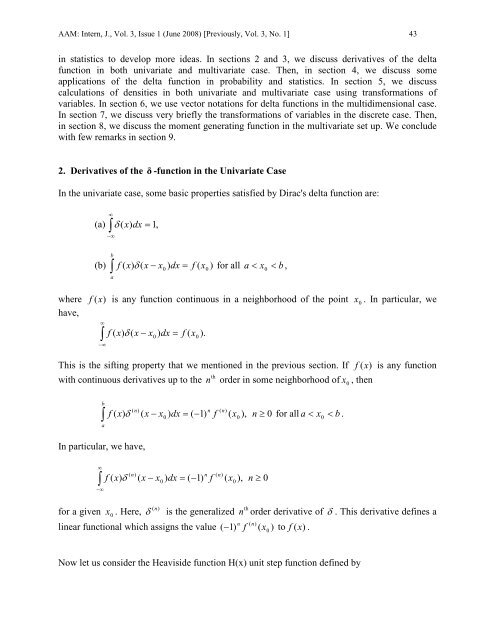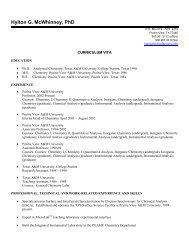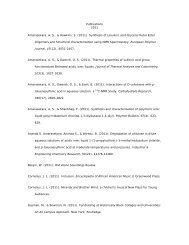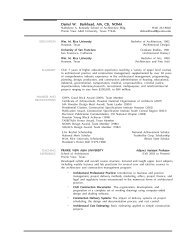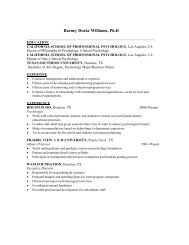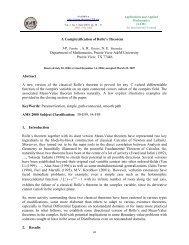Some applications of Dirac's delta function in Statistics for more than ...
Some applications of Dirac's delta function in Statistics for more than ...
Some applications of Dirac's delta function in Statistics for more than ...
Create successful ePaper yourself
Turn your PDF publications into a flip-book with our unique Google optimized e-Paper software.
AAM: Intern, J., Vol. 3, Issue 1 (June 2008) [Previously, Vol. 3, No. 1] 43<br />
<strong>in</strong> statistics to develop <strong>more</strong> ideas. In sections 2 and 3, we discuss derivatives <strong>of</strong> the <strong>delta</strong><br />
<strong>function</strong> <strong>in</strong> both univariate and multivariate case. Then, <strong>in</strong> section 4, we discuss some<br />
<strong>applications</strong> <strong>of</strong> the <strong>delta</strong> <strong>function</strong> <strong>in</strong> probability and statistics. In section 5, we discuss<br />
calculations <strong>of</strong> densities <strong>in</strong> both univariate and multivariate case us<strong>in</strong>g trans<strong>for</strong>mations <strong>of</strong><br />
variables. In section 6, we use vector notations <strong>for</strong> <strong>delta</strong> <strong>function</strong>s <strong>in</strong> the multidimensional case.<br />
In section 7, we discuss very briefly the trans<strong>for</strong>mations <strong>of</strong> variables <strong>in</strong> the discrete case. Then,<br />
<strong>in</strong> section 8, we discuss the moment generat<strong>in</strong>g <strong>function</strong> <strong>in</strong> the multivariate set up. We conclude<br />
with few remarks <strong>in</strong> section 9.<br />
2. Derivatives <strong>of</strong> the δ -<strong>function</strong> <strong>in</strong> the Univariate Case<br />
In the univariate case, some basic properties satisfied by <strong>Dirac's</strong> <strong>delta</strong> <strong>function</strong> are:<br />
where (x)<br />
have,<br />
∞<br />
∫<br />
−∞<br />
(a) δ ( x)<br />
dx = 1,<br />
b<br />
(b) ∫ f ( x)<br />
δ ( x − x0<br />
) dx = f ( x0<br />
) <strong>for</strong> all a < x0<br />
< b ,<br />
a<br />
f is any <strong>function</strong> cont<strong>in</strong>uous <strong>in</strong> a neighborhood <strong>of</strong> the po<strong>in</strong>t 0<br />
∞<br />
∫<br />
−∞<br />
f x)<br />
δ ( x − x ) dx = f ( x ).<br />
( 0<br />
0<br />
x . In particular, we<br />
This is the sift<strong>in</strong>g property that we mentioned <strong>in</strong> the previous section. If f (x)<br />
is any <strong>function</strong><br />
with cont<strong>in</strong>uous derivatives up to the<br />
th<br />
x , then<br />
b<br />
∫<br />
a<br />
In particular, we have,<br />
∞<br />
∫<br />
−∞<br />
f<br />
n order <strong>in</strong> some neighborhood <strong>of</strong> 0<br />
( n)<br />
n ( n)<br />
f x)<br />
δ ( x − x ) dx = ( −1)<br />
f ( x ), n ≥ 0 <strong>for</strong> all a < x0<br />
< b .<br />
( 0<br />
0<br />
( n)<br />
n ( n)<br />
x)<br />
δ ( x − x ) dx = ( −1)<br />
f ( x ), n ≥ 0<br />
( 0<br />
0<br />
(n)<br />
<strong>for</strong> a given x 0 . Here, δ is the generalized<br />
l<strong>in</strong>ear <strong>function</strong>al which assigns the value 1)<br />
( )<br />
f ( x )<br />
n n<br />
− to f (x)<br />
.<br />
th<br />
n order derivative <strong>of</strong> δ . This derivative def<strong>in</strong>es a<br />
( 0<br />
Now let us consider the Heaviside <strong>function</strong> H(x) unit step <strong>function</strong> def<strong>in</strong>ed by


